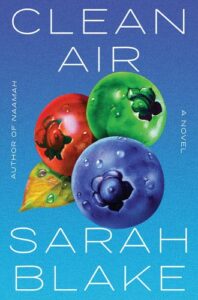My asthma had been getting worse. Almost every spring I was ending up in the emergency room, unable to get my breathing under control. I wheezed and coughed. Once, I could hardly speak. They took me in an ambulance from the doctor’s office to the hospital. Just in case, they said.
At the hospital they had to check for embolisms and pneumonia. I had to take off my underwire bra and stand in front of the X-ray machine with my arms lifted. But my lungs were always clear. The screen, generously black.
When I was first prescribed a steroid inhaler, it was with orders to follow up with a pulmonologist. I hadn’t seen one since my childhood, when I was first diagnosed with asthma. I’d had nearly twenty years with my asthma under control.
To test you for asthma, you blow into a tube hooked up to a computer. Usually you play a game—blow down the little pig’s houses, blow out the candles on the cake. Then you use a rescue inhaler and blow into the tube again. If your breathing improves, then your normal breathing isn’t where it should be.
I needed to use a steroid inhaler for six months before my normal breathing caught up with my assisted breathing. The new inhaler exacerbated my anxiety, and I had to change my medicines to deal with the more frequent panic attacks. But I was glad to have my breathing back.
My asthma had shown itself to get particularly bad for one week in the spring and one week in the fall. My pulmonologist, who was also an allergist, said this corresponded with trees and grasses, primarily. He suggested we repeat the allergy tests from my childhood.
When I was eight, the skin prick allergy test was done on my back. Now that I was an adult, it could all fit on my arms—twelve pricks on one forearm and twelve on the other. And for the ones they needed to know more about, an intradermal test on my upper arms.
After it was over, a nurse slathered my pink arms, swollen with welts, with an ointment that helped with the itching. I was allergic to everything (except ragweed, strangely). The best option was for me to start getting allergy shots.
So I did. Every week for the first year. I signed in and sat in the small waiting room until they called me up. Then I went behind a wall and rolled up my shirtsleeve and waited again. They brought out my vials and asked me to confirm my name. They prepared my injections.
I would look at a Xeroxed piece of paper on a door that I never saw open. Pollination Times for the Philadelphia Area. There were three columns: Species, Pollination Start, Peak. I would look at what tree was peaking that week. I would remember the pink welt on my arm that that tree had made.
I started to imagine a world where everyone was as sensitive to the pollen as I was. Everyone wheezing and coughing and changing the air filters in their houses. Everyone seeking ways to ease an allergy that can hardly be eased, an allergy to something invisible, so dispersed in the air.
And once I created that world, I couldn’t stop. The world kept turning and twisting. The pollen became fatal. The population dwindled. There was horror in every moment. So I imagined the world past that world.
I didn’t want to focus on the moments of destruction. I wanted to focus on the inevitable survival. How society would change—in its small practicalities to its cultural shifts. And how, inevitably, crime would return to their society. I had read enough crime fiction and watched enough procedurals to know they wouldn’t be able to escape it. I spent a lot of time imagining the bizarre that would be normalized. I spent a lot of time trying to imagine how a mother would explain the new world to her child. How she would explain the old one.
When I began writing Clean Air, it began with letters. I wrote forty pages of letters from a mother to her daughter. Trying to explain. Trying to capture. Trying to teach her what was important to know. Trying to parse what was actually important, after importance had become skewed by tragedy and catastrophe.
The mother came into sharp focus for me: Izabel. She was funny and direct and lost. Her letters wandered away from the world as she wrote about her past. She spent many of her letters writing about her own mother, who had died during the imaginary pollen-apocalypse I’d created.
Before dying, Izabel’s mother had struggled as I had. She had chipped teeth after her inhalers weakened them. She was often in the hospital for breathing treatments. She had things done that I’d only researched, like having her air ducts cleaned.
Izabel felt torn between the old world and the new, and she thought of the old world as her mother’s and the new world as her daughter’s. Her daughter, Cami, was so comfortable in the new world, like it wasn’t unusual at all.
I thought of my own son. As my allergies were getting worse, he was growing more and more attuned and attached to nature. He had a “tree friend” at his bus stop, whom he waved goodbye to each morning and hugged when he returned each afternoon. He was so kind, and it seemed like the world would never hurt him. Not yet.
I wanted to help Izabel navigate her way through this new world, to help her feel agency in it, and belonging, and happiness, if I could. So I set the world into motion. I unleashed this one possible future onto the page.
***


















